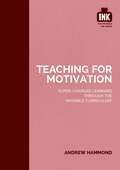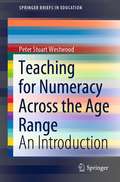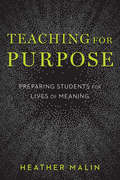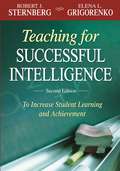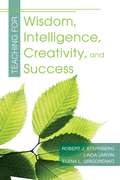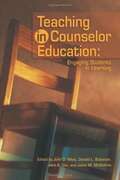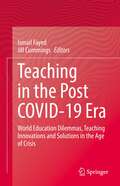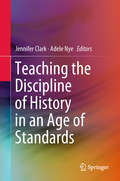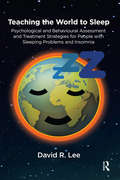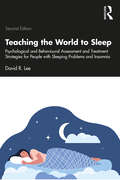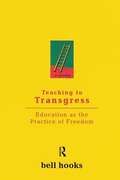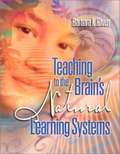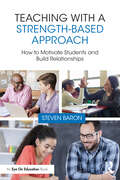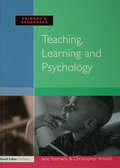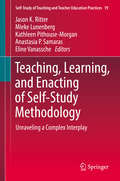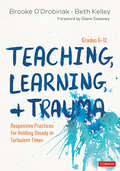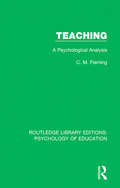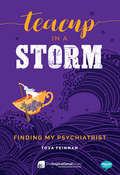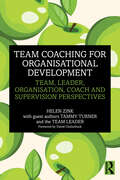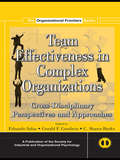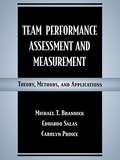- Table View
- List View
Teaching for Motivation: Super-charged learning through 'The Invisible Curriculum'
by Andrew HammondThe Invisible Curriculum series gives teachers the secret ingredients that can fully unlock a child's learning potential. In Teaching for Motivation, Andrew Hammond proves that identifying a child's motivational needs and wants is key to powerful learning.
Teaching for Motivation: Super-charged learning through 'The Invisible Curriculum'
by Andrew HammondThe Invisible Curriculum series gives teachers the secret ingredients that can fully unlock a child's learning potential. In Teaching for Motivation, Andrew Hammond proves that identifying a child's motivational needs and wants is key to powerful learning.
Teaching for Numeracy Across the Age Range: An Introduction (SpringerBriefs in Education)
by Peter Stuart WestwoodThis book provides an introduction to what it means to be numerate, and how numeracy can best be developed and nurtured in children and in adults. It also presents a cohesive coverage of numeracy development from early childhood to adulthood. This book draws on international research and practice to provide a comprehensive overview on the topic. It depicts and draws connections with the National Curriculum in the United Kingdom, the Australian Curriculum, and the Common Core State Standards in the United States. This book identifies skills and concepts involved in achieving functional numeracy, and provides practical advice on effective teaching, learning and assessment. It serves as a valuable guide to educators who teach mathematics in primary and secondary schools, but who are not specifically trained in the subject.
Teaching for Purpose: Preparing Students for Lives of Meaning
by Heather MalinIn Teaching for Purpose, Heather Malin explores the idea of purpose as the purpose of education and shows how educators can prepare youth to live intentional, fulfilling lives. The book highlights the important role that purpose—defined as &“a future-directed goal that is personally meaningful and aimed at contributing to something larger than the self&”—plays in optimal youth development and in motivating students to promote the cognitive and noncognitive skills that teachers want to instill. Based on a decade of research conducted at the Stanford University Center on Adolescence, the book explores how educators and schools can promote purpose through attention to school culture, curriculum, project learning, service learning, and other opportunities. Malin argues for expansive thinking on the direction schools should take, especially in terms of educating students to be creative, innovative, and self-directed critical thinkers. The book includes profiles of six organizations working in schools across the US that have made purpose development a priority. Infused with the engaging voices of purposeful youth, Teaching for Purpose offers a fresh, inspirational guide for educators who are looking for new ways to support students to succeed not only in school, but in life.
Teaching for Successful Intelligence: To Increase Student Learning and Achievement
by Robert Sternberg Elena GrigorenkoCoauthored by two internationally renowned educators and researchers, this resource helps teachers strengthen their classroom practice with lessons that promote successful intelligence--a set of abilities that allow students to adapt and succeed within their environment, make the most of their strengths, and learn to compensate for their weaknesses.
Teaching for Wisdom Intelligence Creativity and Success
by Linda Jarvin Robert Sternberg Elena GrigorenkoThe essential guide for teaching beyond the test! Students with strong higher-order thinking skills are more likely to become successful, lifelong learners. Based on extensive, collaborative research by leading authorities in the field, this book shows how to implement teaching and learning strategies that nurture intelligence, creativity, and wisdom. This practical teaching manual offers an overview of the WICS model--Wisdom, Intelligence, Creativity, Synthesized--which helps teachers foster students' capacities for effective learning and problem solving. Teachers will find examples for language arts, history, mathematics, and science in Grades K-12, as well as: Hands-on strategies for enhancing students' memory, analytical, creative, and practical skills Guidelines on teaching and assessing for successful intelligence Details on how to apply the model in the classroom Teacher reflection sections, suggested readings, and sample planning checklists Teaching for Wisdom, Intelligence, Creativity, and Success is ideal for educators seeking to broaden their teaching repertoire as they expand the skills and abilities of students at all levels.
Teaching in Counselor Education: Engaging Students in Learning
by Don Bubenzer John D. West Jane A. Cox Jason M. McGlothlinTeaching and actively engaging students in learning is a continuous pursuit for counselor educators. We now have the first book in the profession that provides help for this ongoing endeavor. <p><p>Teaching in Counselor Education: Engaging Students in Learning presents thought-provoking ideas for doctoral students in counselor education and also for beginning and experienced counselor educators who wish to continue reflecting on and improving their teaching skills. <p><p> The chapters, written by experienced and highly regarded counselor educators, discuss a variety of teaching practices with practical suggestions for application, describe the authors' personal experiences, and give illustrative case examples. Topics covered include establishing effective student-teacher relationships, using solution-focused evaluations in teaching, delivering lectures, employing experiential learning, utilizing out-of-class learning, implementing distance learning, conducting seminars, making use of technology in teaching, and much more. This book is a valuable tool for readers to consider new perspectives on teaching and learning.
Teaching in the Post COVID-19 Era: World Education Dilemmas, Teaching Innovations and Solutions in the Age of Crisis
by Ismail Fayed Jill CummingsThis handbook showcases extraordinary educational responses in exceptional times. The scholarly text discusses valuable innovations for teaching and learning in times of COVID-19 and beyond. It examines effective teaching models and methods, technology innovations and enhancements, strategies for engagement of learners, unique approaches to teacher education and leadership, and important mental health and counseling models and supports.The unique solutions here implement and adapt effective digital technologies to support learners and teachers in critical times – for example, to name but a few: Florida State University’s Innovation Hub and interdisciplinary project-based approach; remote synchronous delivery (RSD) and blended learning approaches used in Yorkville University’s Bachelor of Interior Design, General Studies, and Business programs; University of California’s strategies for making resources affordable to students; resilient online assessment measures recommended from Qatar University; strategies in teacher education from the University of Toronto/OISE to develop equity in the classroom; simulation use in health care education; gamification strategies; innovations in online second language learning and software for new Canadian immigrants and refugees; effective RSD and online delivery of directing and acting courses by the Toronto Film School, Canada; academic literacy teaching in Colombia; inventive international programs between Japan and Taiwan, Japan and the USA, and Italy and the USA; and, imaginative teaching and assessment methods developed for online Kindergarten – Post-Secondary learners and teachers.Authors share unique global perspectives from a network of educators and researchers from more than thirty locations, schools, and post-secondary institutions worldwide. Educators, administrators, policymakers, and instructional designers will draw insights and guidelines from this text to sustain education during and beyond the COVID-19 era.
Teaching the Discipline of History in an Age of Standards
by Jennifer Clark Adele NyeThis book discusses the discipline standards of History in Australian universities in order to help historians understand the Threshold Learning Outcomes and to assist in their practical application. It is divided into two sections: The first offers a scholarly exploration of contemporary issues in history teaching, while the second section discusses each of the Threshold Learning Outcomes and provides real-world examples of quality pedagogical practice. Although the book focuses on the discipline of history in Australia, other subjects and other countries are facing the same dilemmas. As such, it includes chapters that address the international context and bring an international perspective to the engagement with discipline standards. The innovation and leadership of this scholarly community represents a new stage in the transformation and renewal of history teaching.
Teaching the World to Sleep: Psychological and Behavioural Assessment and Treatment Strategies for People with Sleeping Problems and Insomnia
by David R. LeeSleep problems are ubiquitous in the modern world, significantly impacting on quality of life, mental health, and performance at work and at home. More significantly, sleep problems accompany almost every mental health condition and are a significant driver in the development and maintenance of poor mental health. This book describes the current state of knowledge on the science of sleep, covering the various forms of insomnia and parasomnia that abound, before discussing the variety of assessment and treatment options available to the healthcare practitioner. Further discussion of psychological and behavioural interventions is made with particular reference to a new, second-generation Cognitive Behavioural Therapy for insomnia, how this is an effective treatment modality, and how it can be applied with clients presenting with more complex physical and mental health conditions. The final chapter presents the range of theories as to the purpose and function of dreams and dreaming, and how 'dream-work' has been applied in the therapeutic setting.
Teaching the World to Sleep: Psychological and Behavioural Assessment and Treatment Strategies for People with Sleeping Problems and Insomnia
by David R. LeeTeaching the World to Sleep provides a complete, science-based overview of sleep and sleep problems, from environmental, legal, and technological factors to assessment and treatment options. David R. Lee introduces the basic scientific concepts involved in sleep and provides a clear description of insomnias and the parasomnias. Teaching the World to Sleep discusses NICE-recommended Cognitive Behavioural Therapy for Insomnia (CBT-i) and the REST programme® and outlines considerations for at-risk groups, sleep and the law, and the application of dreams and dreaming in psychotherapy. This second edition includes a full update on research conducted since the publication of the first edition and includes new information on sleep in the legal setting, the rise of sleep apps and trackers and their impact on our sleep. Lee also considers neurodiversity, sleep in long Covid, rare and unusual sleep disorders and the delivery of treatment using the NHS-recommended stepped-care approach. Teaching the World to Sleep will be essential reading for psychotherapists, occupational therapists, and other professionals working with clients with sleep problems. It will also provide an accessible introduction to the science of sleep to readers looking to understand their own sleep problems.
Teaching to Every Kid's Potential: Simple Neuroscience Lessons To Liberate Learners
by Layne Kalbfleisch MED, PhD“Teachers hold the potential to provide a student with frustration or opportunity every day—and those states are closer together than you might think.” When students repeatedly lose track of directions or take a long time to solve problems, it’s easy for teachers to see the distracted or off-task behavior, but not always to see the root of the problem. Quite often the same child who has an underdeveloped skill may have an opposing but hidden strength: a slow processor of information may also be a deep thinker. Teaching to Every Kid’s Potential is an invitation to teachers to improve the learning in their classrooms, one student at a time, using practical, evidence-based strategies. Focusing on four big concepts from neuroscience—flexibility, readiness, connection, and masking—the author shows how to apply them to build on the strengths of students. Each chapter unpacks the science; shows how talents can compensate for neural processing issues and suggests small but powerful adjustments to classroom practice that can allow kids’ gifts to emerge.
Teaching to Transgress: Education as the Practice of Freedom
by Bell HooksWidely admired as a leading black intellectual, hooks is also an inspired teacher. Here, she offers her ideas about teaching that fundamentally rethink democratic participation. These essays face squarely the problems of today's classrooms, including racism and sexism. Ms. hooks sees the gift of freedom--the freedom to think critically--as a teacher's most important goal.
Teaching to the Brain's Natural Learning Systems
by Barbara K. GivenJust as educators divide many subjects into parts, goals, and learning objectives, we can begin to understand the workings of the human brain by focusing on five learning systems: emotional, social, cognitive, physical, and reflective. In Teaching to the Brain's Natural Learning Systems, Barbara K.Given has investigated brain structures and functions of these five systems and applied findings from neurobiology to education without making leaps of judgment or unfounded claims. In this book, she translates neuroscience into an educational framework for lesson planning, teaching, and assessment. Educators can use details from each chapter to add to their repertoire of teaching strategies and instructional approaches. For example, understanding the five learning systems promotes effective, ongoing assessment of youngsters' basic human needs to belong, to know, to do, to reflect, and to be one's self. In addition, each chapter can help teachers' understand the roles they play (mentor/model, collaborator, facilitator, coach, and talent scout) and the personal/professional qualities they bring to the classroom (passion, vision, intention, action, and reflection). This is a practical book for educators based on current neurobiological insights into learning.
Teaching with a Strength-Based Approach: How to Motivate Students and Build Relationships
by Steven BaronHelping students improve doesn't have to mean remediating their deficits. In this important book, Steven Baron shows the benefits of a strength-based approach that instead emphasizes students' assets and capabilities, making them feel more connected to teachers and peers and more engaged in learning. You’ll learn practical, research-backed ways to help students of all grade levels identify and celebrate their strengths, develop self-confidence and a growth mindset, build intrinsic motivation, overcome a fear of making mistakes, manage their feelings, focus on gratitude, and more. You’ll also discover ways to create a more strength-based Individual Education Plan (IEP), increase your own resilience as a teacher, and build a strength-based culture throughout your school and district. The appendix provides a variety of exercises you can use to help students focus on their strengths, foster kindness, and understand the impact of bullying. Students spend approximately 1300 hours during the year with teachers; this resource will help you make this time as affirming as possible so students are ready to learn and grow.
Teaching, Learning and Psychology
by Jane Yeomans Christopher ArnoldPresenting a range of psychological theories in a non-technical and readable style, this book shows how psychology can be used to effectively deliver educational objectives and enhance children’s learning. Linking theory with practical application, the authors consider the wider role that schools can play in the social development of children through: teaching and managing individual pupils teaching and managing groups of pupils the teacher as part of an organisation and school system the teacher as part of the community of the school and area. Structured to reflect the standards for QTS and relevant for key stages 1-4, this book shows how understanding the psychological theories underpinning pedagogy can help both trainee and practising teachers become reflective and informed practitioners when faced with new and challenging teaching situations.
Teaching, Learning, and Enacting of Self-Study Methodology: Unraveling A Complex Interplay (Self-study Of Teaching And Teacher Education Practices Ser. #19)
by Anastasia P. Samaras Jason K. Ritter Mieke Lunenberg Kathleen Pithouse-Morgan Eline VanasscheThis book offers a collection of original, peer-reviewed studies by scholars working to develop a knowledge base of teaching and facilitating self-study research methodology. Further, it details and interconnects perspectives and experiences of new self-study researchers and their facilitators, in self-study communities in different countries and across different continents. Offering a broad range of perspectives and contexts, it opens up possibilities for encouraging the collaborative and continuous growth of teaching and facilitating self-study research within and beyond the field of teacher education. The breadth of the scholarship presented expands scholarly discussions concerning designing, representing, and theorising self-study research in response to pressing educational and social questions. By documenting and understanding what teaching and learning self-study looks like in different contexts and what factors might influence its enactment, the book contributes to building a kaleidoscopic knowledge base of self-study research. Overall, this book demonstrates the impact on participants' professional learning and validates the authenticity and generative professional applications of self-study methodology for and beyond teacher education, providing implications and recommendations for practitioners on a global level.
Teaching, Learning, and Trauma, Grades 6-12: Responsive Practices for Holding Steady in Turbulent Times
by Brooke O’Drobinak Beth KelleyTransform challenging classroom experiences into opportunities for lasting student-teacher relationships, professional growth, and student engagement Chronic stress, anxiety, and trauma have startling effects on teachers and students. The pandemic and distance learning have exacerbated behavior issues and emotional dysregulation, making it difficult for students to engage, learn, and maintain healthy self-esteem. In Teaching, Learning, and Trauma, the authors guide you through the process of creating a learning environment that combats the negative effects of chronic stress and trauma. They show you how to establish rituals and routines, develop personalization, and implement effective student engagement practices that create a relationship-based culture and effectively improve student achievement. This book includes: Self-assessment tools to help teachers make informed decisions Examples of self-care plans and schoolwide policies for maintaining healthy boundaries in and out of school Real-world vignettes and samples of teacher work Planning documents and reflection questions to guide educators in identifying strengths and growth areas Using a synergistic approach, this book unites compelling research data, theories, stories, and best practices from trauma-informed schools, relationship-based psychology, and effective instructional design to dissolve obstacles caused by chronic stress and trauma.
Teaching, Learning, and Trauma, Grades 6-12: Responsive Practices for Holding Steady in Turbulent Times
by Brooke O’Drobinak Beth KelleyTransform challenging classroom experiences into opportunities for lasting student-teacher relationships, professional growth, and student engagement Chronic stress, anxiety, and trauma have startling effects on teachers and students. The pandemic and distance learning have exacerbated behavior issues and emotional dysregulation, making it difficult for students to engage, learn, and maintain healthy self-esteem. In Teaching, Learning, and Trauma, the authors guide you through the process of creating a learning environment that combats the negative effects of chronic stress and trauma. They show you how to establish rituals and routines, develop personalization, and implement effective student engagement practices that create a relationship-based culture and effectively improve student achievement. This book includes: Self-assessment tools to help teachers make informed decisions Examples of self-care plans and schoolwide policies for maintaining healthy boundaries in and out of school Real-world vignettes and samples of teacher work Planning documents and reflection questions to guide educators in identifying strengths and growth areas Using a synergistic approach, this book unites compelling research data, theories, stories, and best practices from trauma-informed schools, relationship-based psychology, and effective instructional design to dissolve obstacles caused by chronic stress and trauma.
Teaching: A Psychological Analysis (Routledge Library Editions: Psychology of Education)
by C.M. FlemingOriginally published in 1968, the findings of modern psychological research had contributed much that was directly relevant to the problems of all who taught at the time. Dr Fleming here presents both recent and past conclusions in a survey that would have been useful to all who were called upon to give instruction. Since its first appearance in 1958 this book had been entirely revised and brought into line with the most modern research. Today it can be read and enjoyed in its historical context.
Teacup in a Storm: Finding My Psychiatrist (Inspirational Series)
by Tova FeinmanA bright and brilliant academic, Tova Feinman had an enviable life. She had a job through which her intellect shone, a loving husband, and a child who adored her. But sometimes, people’s lives are far different than they appear on the outside. Wracked with trauma from childhood abuse, and dealing with her husband’s addiction to pills, Tova sought therapy to soothe her mind.But therapy is not as easy as simply finding a person to talk to. Forging such an intimate – while at the same time appropriate – bond with someone can be a difficult thing to do. Tova built a dangerous relationship with her first therapist, during which she teetered on the edge of oblivion. It was only when this came to an abrupt end that she found her current therapist Dr. Guterson and began to mend herself. Twenty years on, Tova and Dr. Guterson’s relationship remains professional, their bond strong and dependable. Teacup in a Storm tells the journey of a woman looking for the right therapist, and the pitfalls she encountered along the way.
Team Coaching for Organisational Development: Team, Leader, Organisation, Coach and Supervision Perspectives
by Helen ZinkWorking with teams, leading teams and being a member of a team is part of everyday working life for most of us. Through the lens of a team coaching case study, this book considers the development journey of a team and system influences over a three-year period. Readers are invited to walk in the shoes of the team, the team leader, the organisation, the team coach and the coach’s supervision and support networks, providing a unique insight into team coaching and development that goes beyond the traditional focus on the coach’s perspective. Helen Zink uses her considerable experience as a leadership and team growth coach, and leader to illustrate how team coaching interventions can be combined with other disciplines such as positive psychology, change management and strategic implementation in effective ways. The book takes a pracademic approach, showing how theories, models and best practice are applied to a real case and highlighting both the successes and challenges experienced to offer an example for all those involved in team, leadership and organisational development. With it widely recognised that collective leadership and teamwork is needed to deal with the rapidly changing environment organisations find themselves in, this is a timely and important resource for coaches, team coaches, coach supervisors, team leaders, team members, organisational development specialists, change managers, academics and consultants.
Team Effectiveness In Complex Organizations: Cross-Disciplinary Perspectives and Approaches (SIOP Organizational Frontiers Series)
by Eduardo Salas C. Shawn Burke Gerald F. GoodwinOver the past 40 years, there has been a growing trend toward the utilization of teams for accomplishing work in organizations. Project teams, self-managed work teams and top management teams, among others have become a regular element in the corporation or military. This volume is intended to provide an overview of the current state of the art research on team effectiveness.
Team Flow: The psychology of optimal collaboration (SpringerBriefs in Well-Being and Quality of Life Research)
by Jef J.J. van den Hout Orin C. DavisThis book presents a series of studies that conceptualize, test, and monitor team flow experiences in professional organizations to perform autonomously and successfully. It analyses the processes by which team flow emerges by exemplifying case studies, and introduces a protocol to spark team flow in professional organizations.
Team Performance Assessment and Measurement: Theory, Methods, and Applications (Applied Psychology Series)
by Eduardo Salas Michael T. Brannick Carolyn PrinceThis book began at a conference on team performance measurement held at the University of South Florida. Several participants at the conference felt that a book on team performance measurement would be of interest to a broader audience, and they began looking for authors in diverse disciplines. Some of the chapters in this book closely follow material presented at the conference. Many others report work that was done subsequently or was done by authors not present at the conference. The result is a book rich in its diversity of approaches to measurement and which contains illustrations of many different teams. This book is the first of its kind to bring together a collection of scholars and practitioners focusing solely on the problem of team performance measurement. Although much has been written about team and group effectiveness, little theoretical and empirical progress has been made in the measurement of team processes and outcomes. The book represents a major step forward both theoretically and empirically. Section 1 provides a rich theoretical basis for measurement, including designing measures to be used in team training, measures of shared mental models, and measures of team workload. Section 2 addresses methodological developments and issues, including the design and validation of simulations, surveys, and observer checklists. It also deals with issues such as the consistency of team performance and task and level of analysis issues. Section 3 provides applications and illustrations of team performance measures in such teams as nuclear power control room operators, theater technical crews, and aircraft cockpit crews. Section 4 offers guidance for anyone interested in developing their own measures of team performance. There are both theoretical and practical reasons for the current interest in teams. Psychological research interest in groups and teams has returned and is now a thriving area. Self-managed work groups and semi-autonomous work groups have become increasingly common in industry, so there is an increased interest in team functioning from a practical standpoint. This volume's purpose is to describe recent advances in the measurement of team performance, both process and outcome. Several of the chapters provide recommendations on how, when, and why to measure aspects of teams. In addition to describing what is currently known, the book also discusses what remains to be known and what needs to be done next. The book is intended primarily for those interested in research about team processes and outcomes--researchers and academics who possess a basic understanding of statistics and psychometrics. The bulk of research reported has applied aims which provide much practical information, such as how to design simulations, rating forms, and dimensions of team performance useful for feedback to many kinds of teams. In addition, there are examples from several different kinds of teams, including aircrews, nuclear power plant operators, hospital workers, ship combat information center groups, and theater technicians. Therefore the book should be useful to people who want to design measures to evaluate teams.
